

Alphonse Bertillon. Class on the Bertillon system in France in 1911 Alphonse Bertillon (French: [bɛʁtijɔ̃]; April 24, 1853 – February 13, 1914) was a French police officer and biometrics researcher who applied the anthropological technique of anthropometry to law enforcement creating an identification system based on physical measurements.
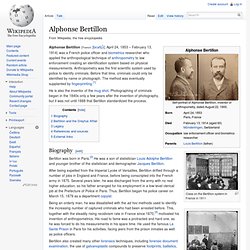
Anthropometry was the first scientific system used by police to identify criminals. Before that time, criminals could only be identified by name or photograph. The method was eventually supplanted by fingerprinting.[1] Crimeline * history of forensic sciences * history of criminology * toxicology * fingerprint * dna analysis * autopsy * arsenic * poison.
Francis Galton. Sir Francis Galton, FRS (/ˈfrɑːnsɪs ˈɡɔːltən/; 16 February 1822 – 17 January 1911) was an English Victorian polymath: anthropologist, eugenicist, tropical explorer, geographer, inventor, meteorologist, proto-geneticist, psychometrician, and statistician.

Locard's exchange principle. In forensic science, Locard's principle holds that the perpetrator of a crime will bring something into the crime scene and leave with something from it, and that both can be used as forensic evidence.
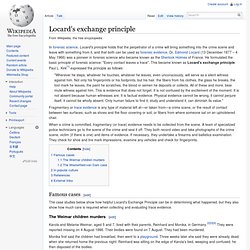
Dr. Edmond Locard (13 December 1877 – 4 May 1966) was a pioneer in forensic science who became known as the Sherlock Holmes of France. He formulated the basic principle of forensic science: "Every contact leaves a trace". This became known as Locard's exchange principle. Paul L. "Wherever he steps, whatever he touches, whatever he leaves, even unconsciously, will serve as a silent witness against him.
Introduction. Serial killers both disgust and fascinate us.

Though we could never fathom commiting such heinous crimes, we nonetheless are intrigued by those who do. Yet, it should be noted that this web page is in no way designed to give "credit" or undo press to these sick and twisted people. Stories about famous serial killers and murder cases at the Crime Library. on truTV.com.
The Frankford area of Philadelphia was once a town older than the City of Brotherly Love itself.
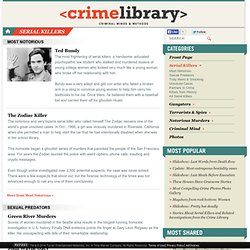
At one time, it was a prosperous area, but by 1980 it had become a crime-ridden slum populated by prostitutes, junkies, and small businesses struggling to survive. This was the area that Sylvester Stallone selected as the setting for his film Rocky. It was here in 1985 where the first victim was found in a railroad yard. Helen Patent was nude from the waist down and she had been posed in a sexually provocative position, with her legs open and her blouse pulled up to expose her breasts. She was 52 when she died, and while it was clear to the police that she had been stabbed many times, it took an autopsy to determine the official cause and manner of death.
Between seven and eight women from 28-68 became the victims of this violent rapist and serial killer in an old section of Philadelphia. Serial Murder. Behavioral Analysis Unit-2 National Center for the Analysis of Violent Crime Critical Incident Response Group Federal Bureau of Investigation Editor Robert J.

Morton Supervisory Special Agent Behavioral Analysis Unit-2 Federal Bureau of Investigation Co-Editor. List of serial killers by country. Crime Scene Investigator Network. CSI: THE EXPERIENCE — Web Adventures. Recording Legible Fingerprints. Introduction to Recording Legible Fingerprints The FBI's Integrated Automated Fingerprint Identification System (IAFIS) is the largest biometric database of criminals in the world.
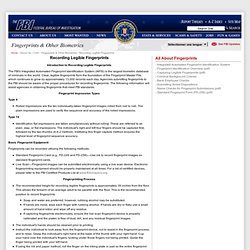
Clear, legible fingerprints form the foundation of the Fingerprint Master File, which continues to grow by approximately 13,000 records each day. Agencies submitting fingerprints to the FBI should be aware of the proper procedures for recording fingerprints. The following information will assist agencies in obtaining fingerprints that meet FBI standards. Fingerprint Impression Types Type 4 Rolled impressions are the ten individually-taken fingerprint images rolled from nail to nail. Type 14 Identification flat impressions are taken simultaneously without rolling.
Basic Fingerprint Equipment Fingerprints can be recorded utilizing the following methods: Standard Fingerprint Card (e.g., FD-249 and FD-258)—Use ink to record fingerprint images on standard fingerprint cards. Fingerprinting Process Special Circumstances. The History of Fingerprints. Fingerprints offer a reliable means of personal identification.
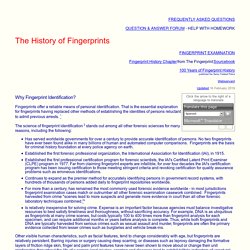
That is the essential explanation for fingerprints having replaced other methods of establishing the identities of persons reluctant to admit previous arrests. 1 The science of fingerprint identification 5 stands out among all other forensic sciences for many reasons, including the following: Other visible human characteristics, such as facial features, tend to change considerably with age, but fingerprints are relatively persistent. Bloodstain Tutorial. The success or failure of any criminal investigation often depends on the recognition of physical evidence left at a crime scene and the proper analysis of that evidence.

Crime scenes that involve bloodshed often contain a wealth of information in the form of bloodstains. The pattern, size, shape, and the location of such stains may be very useful in the reconstruction of the events that occurred. William G. ECKERT and Stuart H. JAMES Bloodstain Pattern Analysis: FIREARMS TUTORIAL. The term ballistics refers to the science of the travel of a projectile in flight.
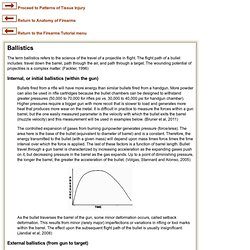
The flight path of a bullet includes: travel down the barrel, path through the air, and path through a target. The wounding potential of projectiles is a complex matter. (Fackler, 1996) Internal, or initial ballistics (within the gun) Bullets fired from a rifle will have more energy than similar bullets fired from a handgun. Ballistics of Modern Firearms. In the past two decades Americans have experienced a turbulent relationship with guns. We are compelled as a society to love them through popular culture and are taught to hate them through the acts of newsworthy criminals.
Through all this, it is easy to view guns as a living force by which we can be either entertained or physically threatened. In reality, firearms are nothing more than engineered mechanical devices, capable of acting in ways both defined and directed by human beings.